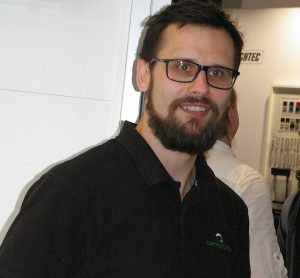SVG Europe Sit-Down: BroaMan’s Maciek Janiszewski on the benefits of fibre and WDM

Maciek Janiszewski, Technical Sales Manager, BroaMan
BroaMan (Broadcast Manufactur GmbH) is a German-based manufacturer of professional and advanced products for broadcasters, production companies, sports facilities, professional AV integrators and others. All its products are geared towards using a fibre infrastructure to integrate video, audio, IP, intercom and other data on a redundant low latency system. With such a wide range of solutions on offer, how does Maciek Janiszewski, Technical Sales Manager, look at the immediate future? SVG Europe finds out…
What do you see as your main challenge for the remainder of 2018?
Probably the main challenge would be the current dispute, which we are monitoring, between broadband and IP video. Our customers are searching for the most future-proof, yet the most stable and powerful, solution. The challenging bit is to educate them and find collectively the most suitable solution, which fits their application perfectly. Sometimes it is IP, in some cases it is broadband video – we are there to help and choose the most appropriate one. Additionally, we provide our unique education programme, which describes pros and cons of all available technologies, also explaining how we can connect it all using our fibre network.
You previously stated that great progress is being made in the number of venues installing fibre. Has that evolution continued, and what are your latest offerings in that area?
Definitely. Every new installation relies on fibre. The cable itself becomes less expensive and the reliability and flexibility, which comes with that medium, is limitless. We have noticed that there are multiple installations running multiple fibres to a number of locations – and we continue to offer endpoint interfaces. However, we have noticed that the number of locations with small channel counts has increased rapidly. We have implemented a series of small and simple converter devices, Repeat8NANO. These are little throw-down boxes allowing conversion of a couple of SDI signals onto fibre. Thanks to this, our product portfolio has widened and we now offer an entire range of products – from simple small-channel-count converters to the advanced routing systems with redundancy.
Has the growth of remote production made a difference to the way you develop products?
Not really. Our products were ready for remote production since day one, offering IP-based control software and high-channel count video, audio, comms and data transport solutions over fibre. Now due to high-bandwidth hardware we can also offer all-over-IP transport solutions.
Along the same lines, is there still an ongoing demand for ‘traditional’ OB vans incorporating your solutions?
Definitely. Most of the OB vans still operate in HD-SDI, even if not going into the 3G, 12G or IP discussion. You just don’t read about it in the news because it is not ‘hot’ and new. Still a lot of users worldwide do not want to rely their production on IP and not a lot of people mention the disadvantages.
For us to be the most flexible, we need to be able to utilise all different technologies, namely combine IP with broadband video – and due to our flexible design, we can easily offer that.
You have stated that “going forward, WDM (Wave Division Multiplexing) is better suited and more capable of expanding than TDM based systems”. Can you elaborate on that statement?
TDM is a great technology. However, nowadays the main thing that changes in professional video world is bandwidth. TDM relies entirely on bandwidth. This means that it is very difficult to increase bandwidth without compromising on the channel count – you could see that when migrating to 4K UHD. A TDM system built for 3G operation would have to either increase the bandwidth four times or divide channel count by four to fit the same TDM bus. As a result, your 40-channel transport system shrinks to 10 channels.
WDM technology doesn’t have those restrictions as it is based on light spectrum rather than the given bandwidth – in the same spectrum we can double, or even make 10 times larger bandwidth without any compromise on channel count. Migrating to 12G is as simple as updating SFP transceiver, while the core WDM multiplexer stays identical as for 3G.
Do you have any future plans you can share with us?
We have quite a lot of interesting developments in the pipeline, and definitely we will be releasing new products at IBC. Watch this space.
We are working on a couple of very nice projects including installations as well as broadcast production.
Also, as mentioned before, we continue our worldwide education programme – anyone interested in fibre should contact our dealers for details.
Do you have an innovative sports related case study you can tell us about?
Our simple and cost-efficient Repeat48 series was deployed in Telefonica OB Vans. They work in Spanish basketball league as well as other sport events, including football Champions League. The customer was searching for an easy way to transport multiple video channels between the stadium and OB truck. We came up with scalable solution based on Repeat48WDM-12 device, which does exactly what the customer requested – not only does it provide the 3G video I/O, but also a fibre tunnel which can be used for Optocore, Dante or any other stream of audio, video or data.
